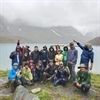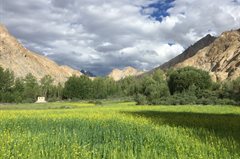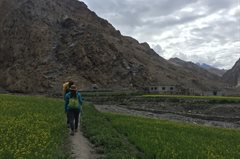
Markha Valley Trek
Markha Valley Trek
Add ons
Available Batches
Available Batches


Brief Itinerary
Detailed Itinerary
Day 1
Arrive in Leh. Rest & Acclimatization.Day 2
Acclimatization in LehDay 3
Drive to Zingchen. (1 Hour). Trek to Ganda La base (3-4 hours)Day 4
Ganda La base - Shingo via Ganda La 6-7 hoursDay 5
Shingo – Sara (5 hours)Day 6
Sara – Markha (4 hours)Day 7
Markha - Thachungtse (5-6 hours)Day 8
Thachungtse - Nimaling (4 hours)Day 9
Nimaling - Shangsumdo via Kongmaru La (7 hours). Drive to Leh
After a hearty breakfast, we will cross Kongmaru La (5200m), the highest pass on the trek, and from here we will have a wonderful view of the Indus Valley and Ladakh Range. The descent is quite steep, but will gradually level out as we enter Shang Gorge, with its fascinating rock formations. More river crossings bar our way before we arrive at the sour-spring of Chuskurmo (used in traditional medicine by the Amchi doctors). Drive from Sumdo to Leh takes about 2 hours. Reach Leh by evening. The trip ends here.
Day 10
Departure from LehWhat's Included
- Camping/Homestay during the trek
- Trek Meals (Starting Lunch on Day 3 till Dinner on Day 9)
- Gaiter, Micro-spikes, and Helmet as required
- Trek Permissions Fee, if any (Upto the amount charged for Indian nationals)
- First aid medical kit including oxygen cylinder
- Experienced Guide and Support staff
- Transport from Leh to Road head and return
- Hotel/Guest House Stays in Leh (Day 1,2 & 9)
- Mountaineering course certified Trek Leader with First Aid certification
What's Not Included
- Meals in Leh
- Meals during road Journeys
- Any kind of personal expenses
- Any kind of Insurance
- Mules or porter to carry personal luggage
- Anything not specifically mentioned under the head Inclusions
- Inner Line Permit Fee
Are you Eligible for this Adventure?
BRS Level Required
Packing List
Frequently Asked Questions
Why Bikat?


Small Group Size
Our batch sizes are capped at 15 for smaller treks with the trek leader and trekker ratio of 1:8. This ratio, in our years of experience, has proven to deliver the best trekking experience for individuals as well as groups. Capping the size of the group ensures individual attention to each trekker so that no signs of distress or need during the trek go unnoticed. It also helps to form a more cohesive cohort with better group energy which helps define the rhythm and pace of days on the trek. As you go higher up on the BRS scale, since the stakes are higher, expeditions have an even smaller group size with the ratio of expedition leader to climber set at 1:2.


Qualified Trek Leaders
We follow a rigorous regime of hiring and training our experts in the field. Each trek leader is a certified mountaineer with years of experience in the field. In addition to their qualification, they also go through practical and situational training to tackle any and all kinds of sudden conditions that may present themselves on the ground. Being unpredictable is the core nature of the mountains but being ready for any circumstance as best as possible is a controllable asset that we try to nurture. Our field experts are also trained in basic medicine and first-aid response. Watch: Forerunners - The Making of A Trek Leader At Bikat Adventures


Guided Progression
Since Bikat Adventures is a learning-based organization, we help you climb up the ladder of difficulty within the sphere of outdoor adventure systematically. Our on-ground training modules are designed to handhold you through the upskilling process so that you are ready to take on bigger challenges.


Equipment Quality and Check
All the gear used on our treks and expeditions is tried and tested, maintained for good quality, and is overall top-notch in quality and condition. We are continually looking to obtain the best of everything there is in the market so as to ensure optimum safety.


Support Systems
Along with the staff you see on-ground, we have a team of superheroes working in the background to give you the best experience possible. Our background team also comprises local staff from each area who know the region best. Having local support helps with studying the area, pre-planning, execution, and in receiving timely support in case of emergencies in these remote locations.


Communication
Our on-field staff is in constant contact with our teams based in primary locations so as to eliminate any avoidable delay in reaching additional help and support when required. We try to use the best tools for communication available, including satellite phones, in regions where they are not restricted.
What our customers Say
Cancellation Policy
Cash refund
Cancellations up to 60 days prior to departure date
Between 60 days upto 30 days prior to departure date
Between 30 days upto 10 days prior to departure date
Less than 10 days prior to departure date
Voucher refund
Cancellations up to 30 days prior to departure date
Between 30 days upto 15 days prior to departure date
Between 15 days upto 10 days prior to departure date
Less 10 days prior to departure date
- Cash refund is applicable only in case of bookings made without using any promotional offer code or Cancellation Vouchers or Discounts
- This is only a brief of cancellation terms. For finer details please refer Detailed Cancellation Policy.
Blog Posts




Similar Adventures

Vasuki Tal Trek
The closest one can get to Mt Shivling on a trek
Uttarakhand
9 Days
BRS 5
4880 m

Kalihani Pass Trek
A challenging and off-beat gem of Himachal
Himachal
8 Days
BRS 5
4800 m

Everest Base Camp Trek
Walk where the Legends walked.
Nepal
14 Days
BRS 5
5545 m






























